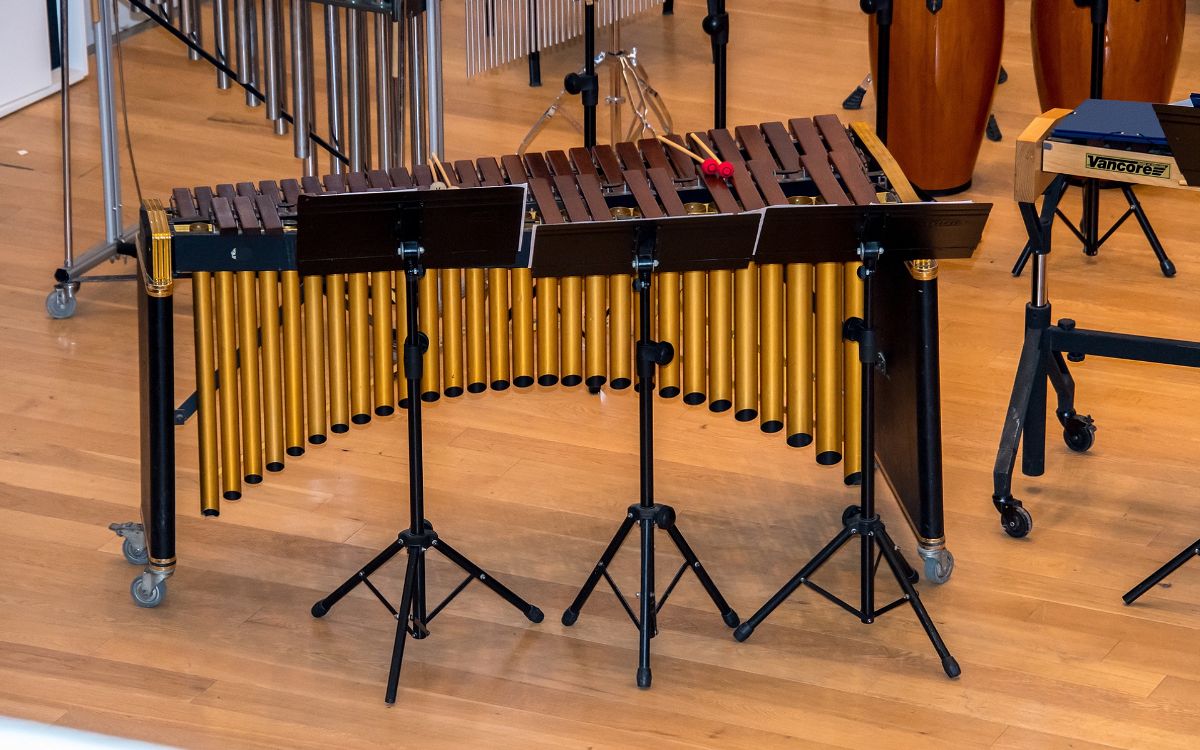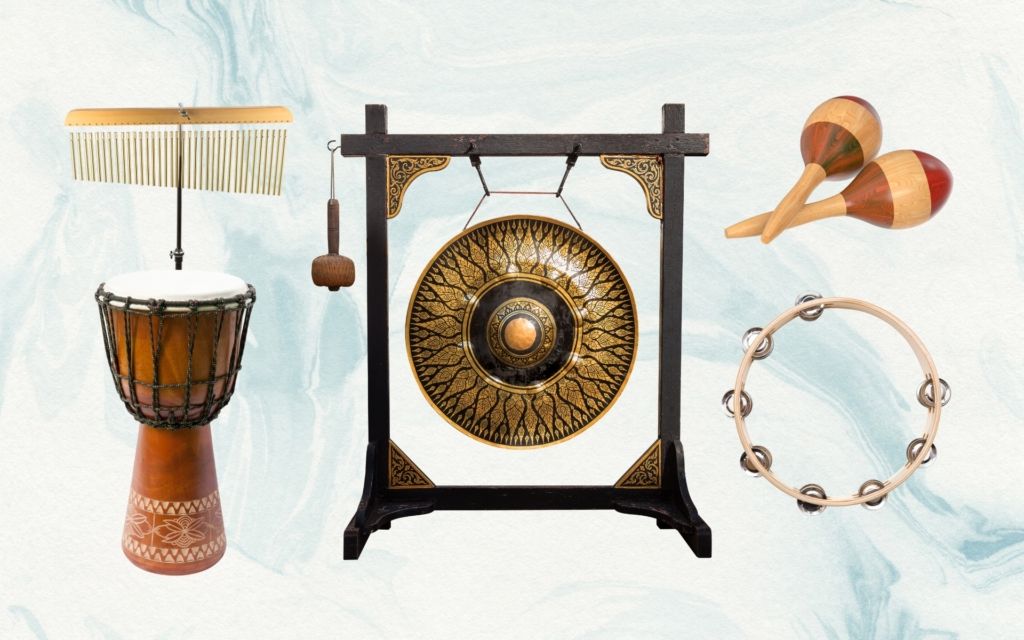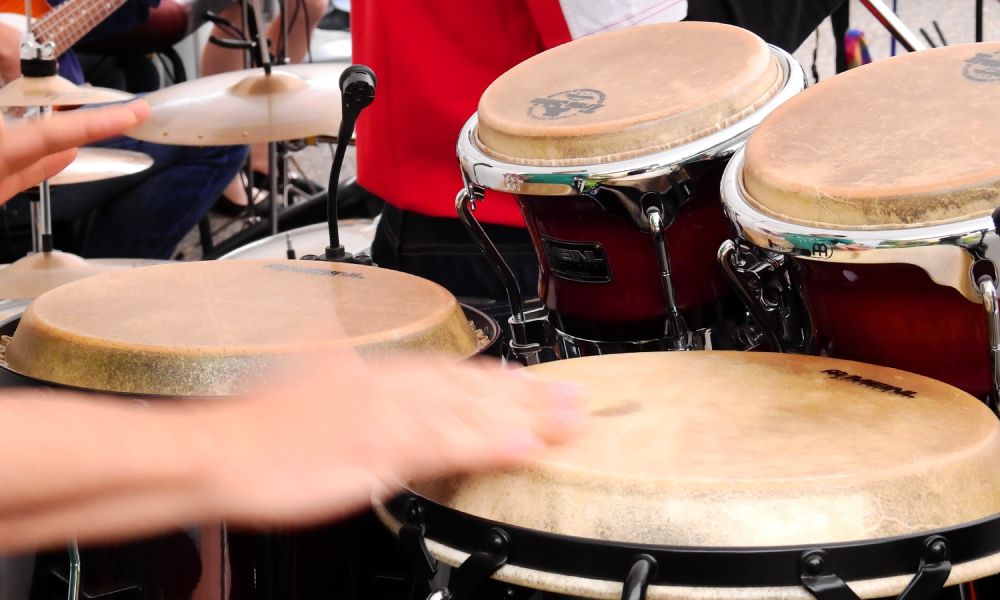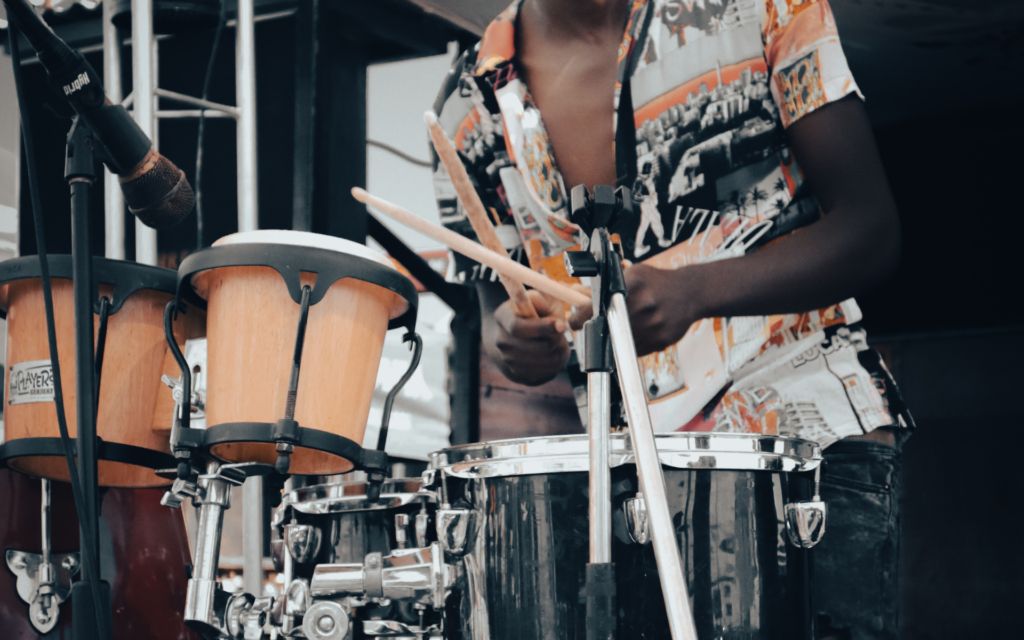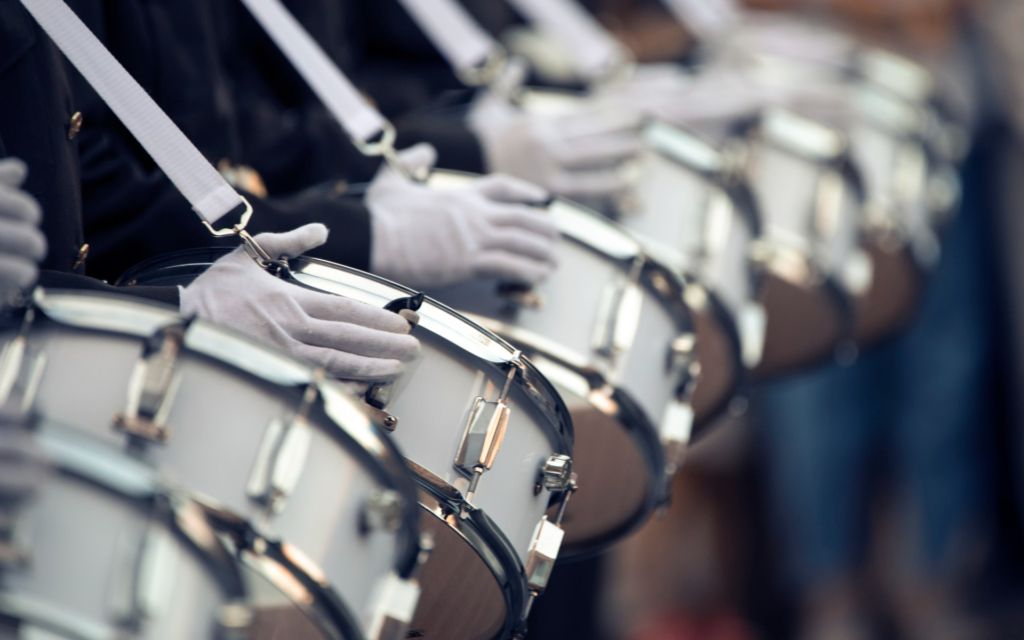Melodic percussion instruments like the marimba, xylophone, vibraphone and glockenspiel share similarities but also have significant differences, which we’ll explore in this guide.
When we think about percussion instruments, it’s common for us to focus more on the drums that make up a drum set, and we often forget that there are many other instruments that belong to the percussion family.
Instruments that combine melody with percussion produce a unique blend of dynamic and tonal qualities.
The most popular of these instruments is the piano, of course, but there are four other pitched percussion instruments worth learning about – the marimba vs. xylophone vs. vibraphone vs. glockenspiel.
These four instruments are often grouped together because they share several attributes in terms of sound and physical design. However, there are also many important differences between them which give each of these instruments a uniqueness.
In this guide, we’ll cover the specifics of the marimba, xylophone, vibraphone, and glockenspiel, comparing all of the important aspects of these percussive instruments.
Contents
Marimba
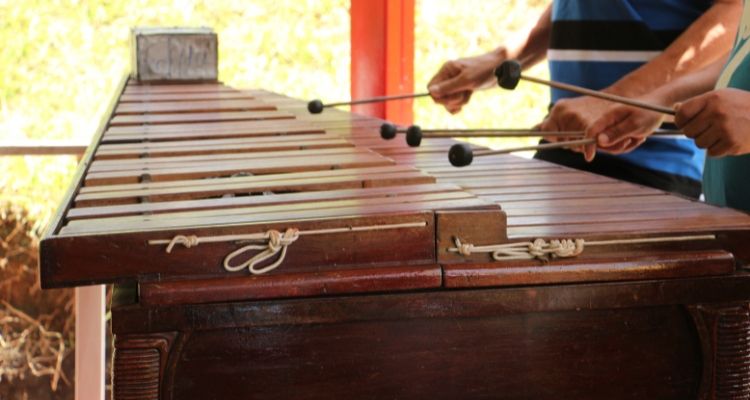
History and Origins
Although there is some debate over when and where exactly the marimba originated, it is thought that it was invented by African slaves from Mozambique who were brought to Mexico during the 16th century.
It likely combined two earlier percussion instruments – one from Africa and one from the Mayan people of Mexico.
The marimba we know today was developed in Guatemala during the late 19th century and is still a popular instrument in Central America. In the early 20th century, the marimba gained popularity in North America as a result of various jazz musicians using it.
Design and Mechanics
The marimba consists of a set of wooden bars which are held above a frame.
Each bar is tuned to a specific note, and the notes are arranged in chromatic order, and underneath the bars is a set of resonators or tubes that amplify the sound of the instrument.
Playing Technique,
This instrument is usually played with two mallets in each hand, although some players prefer to use four mallets. The mallets are designed with a round head, which gives them the perfect combination of bounce and attack for producing a dynamic sound on the marimba.
Additionally, marimba mallets are usually held in an overhand grip and used to strike the bars of the instrument, and using several allows the musician to play chords.
Sound & Dynamics
The marimba is capable of producing a wide range of sounds and dynamics. The sound is often described as being very warm and woody, but it can also be bright and resonate with a lot of sustain, depending on the playing techniques used.
Suitable Styles & Genres
Compared to the other pitched percussion instruments, the marimba has a unique sound that is perfect for creating musical textures and subtle variations in dynamics. This makes it an ideal instrument for adding interest and depth to any musical genre.
However, the marimba has been used predominantly in jazz, Latin, and African styles of music. It has also been used in many different fusion genres, such as jazz-funk and other forms of world music.
Xylophone
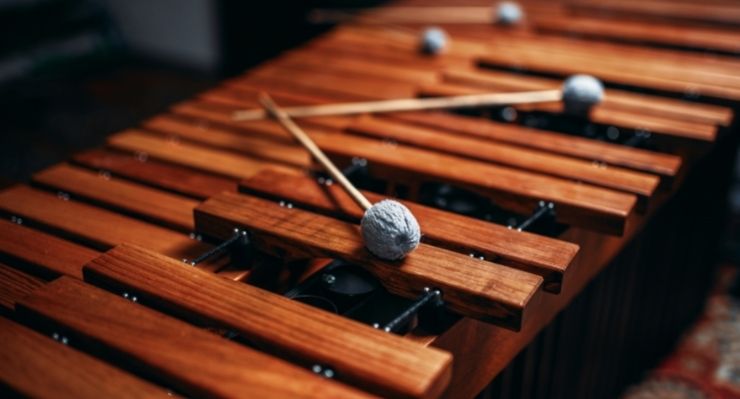
History and Origins
Like the marimba, the history of the xylophone is also somewhat shrouded in mystery. It is believed that it was first created in Southeast Asia during the 14th century and is thought to have been inspired by an earlier version of the marimba.
Later, in West Africa, an instrument called the balafon was commonly also called the xylophone. It was then popularized in Europe during the 17th century and eventually evolved into the xylophone we know today.
Design and Mechanics
The xylophone consists of a set of wooden bars which are held above a frame. Each bar is tuned to a specific note, and the notes are arranged in chromatic order, like on a keyboard or piano.
Underneath the bars is a set of resonators or tubes that amplify the sound of the instrument.
Compared to the marimba, the xylophone is noticeably smaller and uses thinner bars, making it a more practical instrument to play at home.
Playing Technique
The xylophone is usually played with two mallets in each hand, and the technique often involves playing two notes at once to form a chord. The conventional grip is overhand, and the mallet heads should be slightly rounded like those used for the marimba.
Sound & Dynamics
The xylophone is capable of producing a range of dynamics from soft and sustained to bright and sharp-sounding attacks. It is known for its bell-like, crystal-clear tones and has a very distinct sound that can cut through any arrangement.
Suitable Styles & Genres
This versatile instrument is used in a variety of musical genres, but similarly to the marimba, it’s especially popular in jazz and Latin music. Its bright and clear sound makes this instrument a great choice for providing texture and complexity to any orchestral arrangement.
Vibraphone
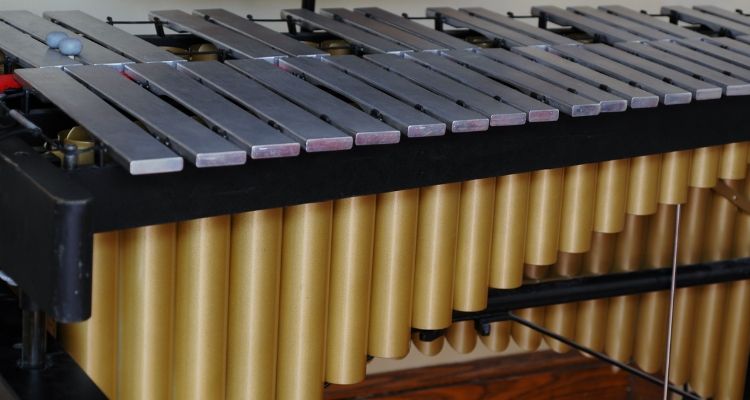
History and Origins
The vibraphone has an interesting origin story, which begins in the mid-1910s with an instrument manufacturer name Herman Winterhoff., who had the vision of creating an instrument that could create vibrato and sustain, similar to the human voice.
After experimenting with different designs, Winterhoff shared his idea with jazz musician Lionel Hampton, and the two of them went on to invent and popularize the vibraphone.
Design and Mechanics
The vibraphone is similar in design to the xylophone, with a set of metal bars. However, the bars are made of a softer metal alloy, so they produce a much softer and mellower tone.
Resonators are also used, as is a dampener that can be used to change the notes’ sustain length.
The vibraphone also has a unique feature – an electromechanical motor that oscillates the tubes beneath the bars to produce a vibrato effect.
Playing Technique
This instrument is usually played with two mallets in each hand, similar to the two previously mentioned percussion instruments. The mallets should be slightly curved and made from rubber, and a different color is commonly used for each hand.
Sound & Dynamics
The vibraphone produces a very unique and distinctive sound. Its mellow and bright tones are instantly recognizable, and the addition of the vibrato effect creates a beautiful tonality.
Furthermore, it is capable of producing dynamics from very soft and subdued to bright and sharp attacks.
Suitable Styles & Genres
Vibraphones were initially used by jazz musicians in the early 20th century, but their use has also spread across many popular and classical music genres over the years. It has been used in music genres from funk and soul to classical, rock, pop, and even more modern styles like EDM.
Glockenspiel
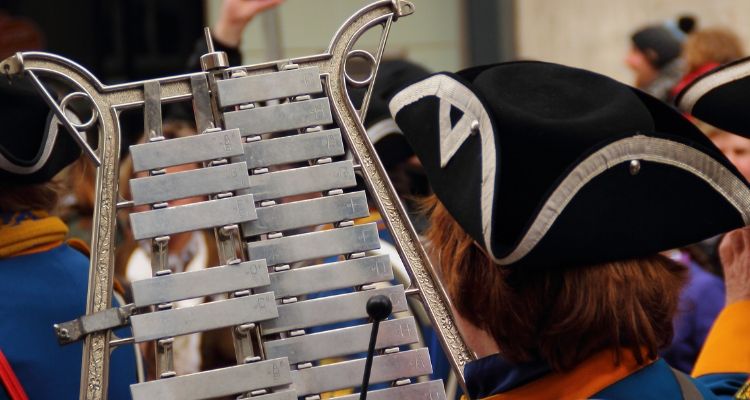
History and Origins
Originating in the late 16th century in Germany, the glockenspiel is a type of percussion instrument similar to the xylophone and vibraphone. It was originally played by the town musicians to attract people to churches and other important events.
The glockenspiel was popular throughout Europe for centuries, and its popularity was eventually brought to the United States in the late 19th century.
Design and Mechanics
The glockenspiel is made up of metal bars with different notes and lengths. It is usually mounted on a stand, and like the xylophone, it has resonators beneath each bar to help project the sound.
Playing Technique
Like the aforementioned instruments, the glockenspiel is typically played with two mallets in each hand. The mallets should be slightly harder than those used for the xylophone and vibraphone, as the glockenspiel has much smaller bars and requires more force to get a good sound out of them.
Sound & Dynamics
The glockenspiel produces a treble-heavy tone with a distinct ringing sound. The attack is sharp and precise, making the glockenspiel naturally good for solo performances.
Dynamic-wise, the glockenspiel has a rather limited range. It’s difficult to make it louder than the other instruments it is playing with, and the sustain of notes is very short.
Suitable Styles & Genres
This instrument is relatively versatile and has been used in many genres in the Western world and other cultures. It is commonly used in classical, jazz, pop, and rock music. It also features heavily in many movie soundtracks and video games.
Its natural sound often adds a light-hearted feel to the music, making it the perfect choice for uplifting and cheerful compositions.
Comparing Note Range & Pitch
An important difference between these four popular percussion instruments is the range of notes that they are able to play.
Some are more limited than others, and it’s possible to find different versions of a particular instrument that is designed to produce a lower or higher range of pitches to suit certain styles.
Marimba Note Range
The marimba doesn’t have a standardized range and usually comes in 4.3, 4.5, 5, or 5.5-octave versions. A 4-octave version is also available, with a range from C3 to C7.
Xylophone Note Range
The xylophone typically comes in two sizes – soprano and bass.
The soprano xylophone has a range of 3.5 octaves (F4 to C8), while the bass xylophone has a range of 4 octaves (C4 to C8). When it comes to transposition, the xylophone is usually read one octave lower than the treble clef.
Vibraphone Note Range
The most common version of the vibraphone has a range of 3 octaves (F3 to F6 in most cases). However, larger 3+1⁄2 or 4-octave models (C3 to F6 or C7) are becoming increasingly popular as musicians look to expand their options when playing it. . .
Glockenspiel Note Range
The glockenspiel has the smallest range of the four instruments we’ve covered. It typically comes in 2 1⁄2 or 3-octave versions, with the highest note normally the fourth C above middle C – exactly two octaves apart.
Similarities Between The Four Instruments
Despite the differences in note range and playing technique, there are several similarities that can be observed between the marimba vs. vibraphone, glockenspiel, and xylophone.
- All of them are made up of metal bars with resonators underneath.
- They all require two mallets to be played properly.
- They each have a sharp attack and naturally treble-heavy sound.
- They are commonly used in many genres of music and are widely featured in movie and TV soundtracks.
- They add a bright and percussive feel to the compositions they are used in.
Despite these similarities, learning to play one of the instruments we’re discussing doesn’t necessarily mean that you will be able to play the others. Each instrument still has its own unique characteristics, from the range of notes available to the playing technique required.
In order to become a proficient player on each one, you will need to learn it in detail, taking into account all of its unique characteristics.
For example, the xylophone is made up of chromatic notes, while the marimba and vibraphone are commonly diatonic. This means it could be difficult to transfer your skills from one instrument to another.
Which is Easiest to Play?
When it comes to musical instruments, there is no single easy or hard instrument – it all depends on your experience with the various instruments and how much practice you put in.
That said, when comparing the vibraphone vs marimba, xylophone, and glockenspiel, there are some key differences that can make one instrument easier to play than the other.
The marimba is generally considered more difficult than the xylophone, vibraphone, and glockenspiel as it requires greater control of dynamics and a higher level of skill in order to play it to its fullest potential.
Marimbas are also larger instruments that can require more hand and arm strength and agility to play.
In contrast, the xylophone, vibraphone, and glockenspiel are all smaller instruments that typically use wooden or metal bars, which need less control of dynamics since they can produce a louder sound more easily.
The glockenspiel is particularly easy for beginner players since this instrument has a fixed pitch, making it less complicated to learn than the others.
Overall, each of these instruments requires practice and dedication to master. If you’re looking for an easier instrument to start playing, then the glockenspiel is probably a good choice, but for more of a challenge, then the marimba will provide this!

